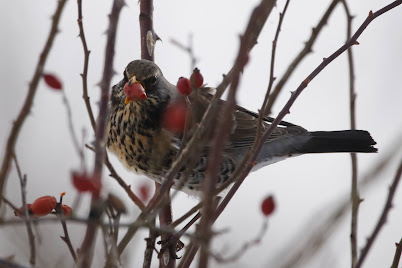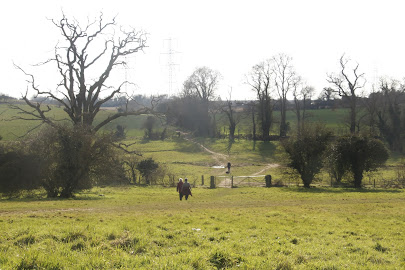As is usual for this time of year, winter was grey and miserable on the Patch. Lots of rain, heavy frosts and overcast days set for some dreary walks. And then on 7 February heavy snow fell and the world became white. The snow hung heavy on the Patch, although not too deep, maybe six inches or thereabouts. As the snow lay there there were some beautiful days with some great light enlivening the environment. The Patch is well walked and therefore the paths never became impassable. The pond and the reservoir froze over, although the stream still flowed. After a while, however, the novelty of the snow soon wore off and the snow became dirty, and the paths slippery, as it slowly melted. The snows lasted around a week before being washed away by the rain. The rest of the period was very mild and sunny preparing the ground for Spring.
The star bird of the period was a RED KITE flying over Rise Hall, harassed by the local CROWS. It is so unmistakable when compared to the other local bird of prey, the buzzard, the kite has a forked tail, its pushed back, pointed wings and its orange colouring. From just a few pairs in Wales, the red kite has now spread to every corner of the land. This is a first record for the Patch, and with increasing records in Suffolk, maybe one to colonise in the future.
A female STONECHAT was a decent sighting on 24/2 in the former horse pastures behind First Field. A typical early migrant, it begins moving when other birds still feel it is winter. This is only my second record for the Patch, the other record also occurring at this time. Stonechat populations are at a historical high due to the excellent management of Suffolk's heaths, which are their breeding grounds, and should become more common in the future.
Winter brought in new birds to the Patch. This season, specifically November and December, brought in the biggest movement of REDWINGS I have seen in years. Located mainly around the Suffolk Punch Field there were maybe over a hundred present at a time. They were often very wary, and would seldom settle, flying into the trees and scattered bushes, before flying up again at the slightest provocation. Mid-winter there was a lull with only a few records as they left the Patch. However towards the end of February the birds returned, maybe as Spring migrants. A flock of 70 on 17/2 were found amongst the horse paddocks, an interesting record.
BLACKBIRDS were also very common this winter, and were perhaps the most noticeable bird on the Patch, with many a bird feeding by a hedgerow or flying low. Despite all this, however, FIELDFARE, the other winter thrush, were only present in ones or twos.
A nice record was a pair of BULLFINCHES by the Pond, on 1/1, birds that don't flock but live in pairs for life, their melancholy call and white rumps are a good way of identifying the birds. This species goes through peaks and troughs and at the moment is quite scarce on the Patch.
Someone has put up feeders along the northern part of Old Norwich Road, toward the edge of the Patch, and among the commoner birds scoffing away there were a pair of COAL TITS, rare birds on the Patch, feeding under the drone of the A14.
Both GREEN and GREAT SPOTTED WOODPECKER are resident on the Patch, and I see them most days. Early February there were three great spotted woodpeckers in the tall trees around Rise Hall. A bird is on territory here most years, and he seemed to be chasing some interlopers away. It won't be long before it starts to drum, to announce his availability to the females. Green woods are harder to pin down as they are often seen whenever there are trees, and their "yaffelling" call can be heard around the Patch.
The BUZZARDS were as usual present all year, whilst a male KESTREL was also present, although he never seems to attract a mate. However the little owl I saw last year hasn't been located for some time, so may have moved on, which is a shame.
Waterbirds are always scarce on the Patch as there is only a little stream, a reservoir, and a little pond. MALLARDS peaked at twelve, and six CANADA GEESE at the end of January was unusual.
An unusual record of a common bird was a flock of 30 MAGPIES in the First Field. A relatively unsociable bird, they are usually only seen in ones or twos, a group of magpies is called a PARLIAMENT.
In winter birds are the species I see most on the Patch, however aside from my feathered friends there were some other forms of life. A few mammals were about. A RED FOX was present in the meadow behind the sports centre, on 29/12, slinking by one of the hedgerows. I have seen foxes in many cities, including in central London, but for some reason they are scarce in Ipswich, and this is my only second record for the area. Another scarce record was a MUTJAC on 8/1. With little wooded cover, this alien deer is quite rare on the Patch.
As the new year begins, and with a few months under the belt, signs of spring flowers start to appear. SNOWDROPS have begun to grow, in the area of scrub at the beginning of the Patch, at Rise Hall, and around the church. Also appearing under the trees at Rise Hall, yellow LESSER CELENDINE are also flowering another nice, early flower.
Even those areas of countryside that have nothing in particular to distinguish themselves can be good for birds. Nature can't sit in nature reserves, prisons with no way out for them. It is up to the general countryside to provide room for our wildlife to survive and to provide room for movement. Protecting hedgerows, and those corners of fields where the flowers grow are paramount for giving wildlife a home. Maybe post brexit, British farming policy will change for the better for wildlife, it can't get any worse. Maybe in the future we will live in a society that sees value in nature, as something to cherish, and not destroy.













No comments:
Post a Comment